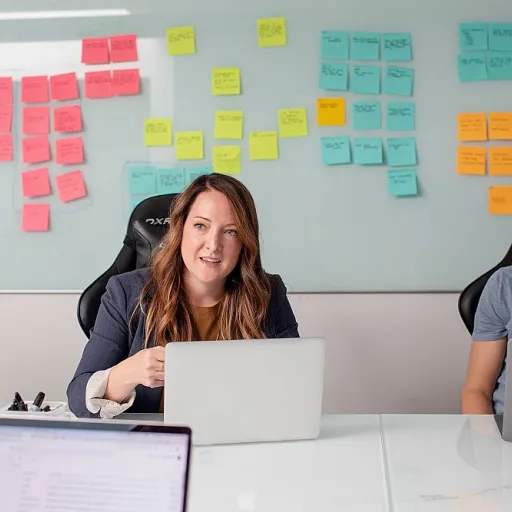
Understanding the Paperless Practice
Bidding Farewell to Traditional Filing
The concept of going paperless in practice isn't a new idea, yet it's one gaining significant traction in the realm of continuous learning. The paperless approach involves eliminating, or drastically reducing, the reliance on physical paper documents in favor of electronic formats. This transformation isn't just about ditching paper; it's about embracing a new way of managing information and harnessing the power of technology.
In an office setting, transitioning to a paperless practice not only revolutionizes the way files and documents are handled but also optimizes efficiency. The practice of paperless management includes storing documents electronically. This process often includes using advanced software and systems that allow for seamless document handling, reducing the need for traditional filing cabinets. The extensive time previously spent sorting through filing cabinets can be refocused on more pressing business concerns, allowing teams to be more productive.
Moreover, the paperless approach aligns with the environmentally friendly movement by significantly reducing paper waste. This shift from paper to electronic means contributes to conserving resources, reducing the need for paper production, and the costs associated with recycling. Handling documents in this manner not only saves money but also helps in efficiently reducing the ecological footprint of any practice or business.
With continuous advancement in technology, electronic documents can be leveraged in ways paper never could. This offers an enhanced user experience and facilitates the integration of practice management systems. For anyone contemplating this shift, it's crucial to understand the implications of electronic image handling and billing, which is part of a much broader digital transformation.
To master these changes and achieve success in your transition, it might be helpful to learn from each other's experiences. By adopting these methods and embracing the transformation, businesses and educational entities can streamline their processes and gain a competitive edge in today's digital age. For those interested in further optimizing their operations, mastering this approach can offer valuable insights into boosting efficiency and productivity.
Benefits of Going Paperless
Revealing the Advantages of a Digitized Environment
Adopting a paperless practice within a continuous learning framework offers an array of benefits that can propel both businesses and individual learners forward. Firstly, transitioning to electronic files significantly enhances efficiency. The time previously spent rummaging through filing cabinets is drastically reduced. With digital documents, organizations can optimize their resources, leading to a streamlined workflow where accessing information is just a few clicks away. Going paperless also holds considerable environmental advantages. Reducing paper waste is not only environmentally friendly but aligns with sustainable business practices. Moreover, recycling initiatives become more straightforward with digital formats. Fewer paper documents and a decrease in office paper use contribute to a smaller carbon footprint. In terms of cost, the financial savings are notable. Companies will save on overhead expenses related to paper purchase, storage, and disposal. Implementing practice management software minimizes paper billing and filing needs by keeping everything organized electronically. Furthermore, less physical clutter leads to a more engaging and less stressful working environment. The accuracy and reliability of data improve with digitization. Electronic images and documents are less prone to errors often seen in manual paperwork. Such a system also lends itself to better document sharing, allowing for collaborative efforts without the friction of physical document transfer. Finally, a paperless system ensures a seamless integration with modern technologies, enhancing the learning experience. Those in continuous learning environments benefit from interactive modules, enriched multimedia content, and easy access to updated material. This shift not only improves engagement but also supports adaptive learning strategies. To learn more about how a comprehensive approach can aid your learning journey, consider exploring workflow integration strategies that can enhance your experience with a 360-degree approach. Embracing these benefits requires careful consideration and planning. The challenges of implementing such a system and strategies for successful transition will be explored further. However, the potential rewards offer a compelling argument for transitioning towards a paperless future.Challenges in Implementing a Paperless System
Overcoming Barriers to a Paperless Transition
Implementing a paperless practice in a learning environment doesn't come without its fair share of challenges. A major hurdle often encountered is resistance to change. Decision-makers and staff members might be comfortable with traditional practices involving paper documents and filing cabinets, finding it daunting to adjust to a more electronic system. Another challenge is ensuring the security and confidentiality of electronic files, which many professionals find crucial, especially when handling sensitive documents. While the shift eliminates paper waste and supports an environmentally friendly approach, it also demands robust cybersecurity measures to protect data integrity. Additionally, the transition requires upfront investment in digital tools and software, which can be significant for businesses with limited resources. Even though going paperless can reveal long-term cost savings, the initial spending might deter some organizations from taking the plunge. Technical difficulties, such as staff unfamiliarity with new systems, pose another challenge. Without proper training, users can struggle with the functionalities of practice management tools, leading to frustration and efficiency reduction. Patient experience and practice management can also be affected during the transitional period as the process of digitizing files and setting up electronic document systems might temporarily disrupt regular operations, necessitating patience and a well-structured implementation plan. Ultimately, the successful integration of this approach hinges on clear communication and the willingness of all involved parties to engage with the change. Providing adequate training and support throughout this journey will save time and resources in the long run, facilitating a seamless transition to a modern, paperless office. For those focusing on enhancing the transition process, utilizing a drafter interview feedback form can provide valuable insights and improve practice across the board, making continuous learning a core part of the journey.Tools and Technologies for a Paperless Learning Environment
Unlocking the Potential of Digital Tools for a Greener Learning Space
In today's fast-evolving digital era, embracing electronic files instead of paper documents can drastically enhance the management of resources within a learning environment. The transition to a paperless practice involves utilizing a wide array of tools and software that cater to different needs, from document management to student engagement. Modern practice management software offers a comprehensive solution to replace traditional paper filing systems. These platforms not only store documents securely but also facilitate easy retrieval, saving time and reducing the need for filing cabinets. As a result, efficiency is improved while paper waste is minimized, aligning with the environmentally friendly goals of many organizations today. To further optimize the paperless practice, many institutions have integrated cloud storage systems. With providers offering scalable options, these systems allow learners and educators to access documents anytime, anywhere, thereby enhancing the learning experience. This accessibility ensures that paper documents are replaced with digital counterparts that are easily shareable and editable. Additionally, image scanning technology plays a crucial role in the digitization process. High-resolution scanners convert physical documents into digital files, enabling a seamless filing process within the virtual office space. As a result, resources that were previously tied up in managing physical files can now be directed towards more constructive activities. Electronic tools and resources designed for billing and administrative tasks also contribute to the paperless transition. Implementing billing systems that handle all transactions electronically not only boosts the office's operational efficiency but also simplifies tasks for both learners and administrators, leading to significant time savings. The evolution of digital solutions is indeed reshaping continuous learning, making the experience more effective while supporting sustainability goals. By effectively leveraging technology, educational institutions and businesses alike can transform their offices into more efficient, paperless environments, saving time and resources in the process.Strategies for Successful Transition
Preparing for the Transition
Transitioning to a paperless practice requires careful planning and strategic implementation. The initial step is to assess your current paper usage and identify areas where electronic solutions can replace traditional paper documents. This involves evaluating your office's filing systems, billing processes, and patient records to determine how they can be digitized.
Investing in the Right Tools
To ensure a smooth transition, investing in the right software and technologies is crucial. Practice management software can help streamline operations by managing electronic files and reducing reliance on paper documents. Additionally, cloud-based storage solutions offer a secure and efficient way to store and access documents, eliminating the need for bulky filing cabinets.
Training and Support
Training staff is essential to ensure they are comfortable with new technologies and processes. Providing comprehensive training sessions and ongoing support will help employees adapt to the paperless environment, enhancing their experience and efficiency. This not only saves time but also reduces paper waste, contributing to an environmentally friendly office.
Monitoring Progress and Adjusting Strategies
Once the transition is underway, it's important to monitor progress and make necessary adjustments. Regularly reviewing the effectiveness of the paperless system will help identify any challenges and areas for improvement. This continuous evaluation ensures that the practice remains efficient and that resources are used optimally.
Encouraging a Culture of Sustainability
Finally, fostering a culture that values sustainability and the benefits of going paperless can motivate staff to embrace the change. Highlighting the environmental impact of reducing paper waste and the long-term benefits of a paperless practice can encourage everyone to contribute to the success of the transition.
Case Studies and Real-World Examples
Proven Success Stories and Tangible Outcomes
Real-world experiences offer invaluable insights into the transition towards a paperless practice. Many organizations have embraced this shift and witnessed remarkable improvements in efficiency, resource management, and environmental impact. By replacing traditional filing cabinets with electronic systems, businesses have significantly reduced paper waste and office clutter. Let's explore a few practical examples of entities that have executed a paperless approach successfully:
- Healthcare Sector: Numerous healthcare providers have adopted electronic filing systems facilitated by practice management software. This initiative not only minimizes time spent on searching patient files but also enhances the efficiency of document retrieval. As a result, medical professionals can focus more on patient care rather than administrative duties, contributing to a more effective healthcare service.
- Law Firms: Legal practices have moved towards an electronic document management system, replacing rows of filing cabinets with digital files. The switch enhances security while providing easy access to sensitive documents whenever they are needed.
- Educational Institutions: Schools and universities that have implemented paperless environments for learning have saved substantial resources. They utilize digital platforms for assignments and grading, thereby reducing paper consumption and allowing educators to streamline administrative tasks.
The transition journey varies across industries, yet the underlying success factor is the strategic implementation of the right tools and technologies coupled with a willingness to adapt. Moreover, businesses report that going paperless saves not only time and effort but also financial resources in the long run. Environmentally friendly practices like recycling are integrated within this approach, bolstering an organization's commitment to sustainability.












